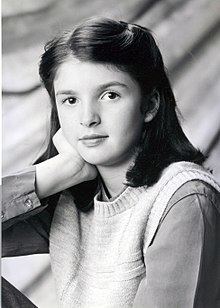Nationality American Role Researcher Residence United States of America | Name Emily Rosa Parents Larry Sarner | |
 | ||
Born February 6, 1987 | ||
STOSSEL TESTING THERAPEUTIC TOUCH
Emily Rosa (born February 6, 1987 in Loveland, Colorado) is the youngest person to have a research paper published in a peer reviewed medical journal. At age nine Rosa conceived and executed a scientific study of therapeutic touch which was published in the Journal of the American Medical Association in 1998. She graduated from the University of Colorado at Denver in 2009 with a major in psychology. Her parents, Larry Sarner and Linda Rosa, are leaders of the advocacy group Advocates for Children in Therapy.
Contents
- STOSSEL TESTING THERAPEUTIC TOUCH
- Therapeutic Touch study
- Reaction
- Therapeutic Touch experiment
- Other work
- Appearances
- Publications
- References
Therapeutic Touch study
In 1996, Rosa saw a video of Therapeutic Touch (TT) practitioners claiming they could feel a "Human Energy Field" (HEF) emanating from a human body and could use their hands to manipulate the HEF in order to diagnose and treat disease. She heard Dolores Krieger, the co-inventor of Therapeutic Touch, claim that everyone had the ability to feel the HEF, and Rosa heard other nurses say the HEF felt to them "warm as Jell-O" and "tactile as taffy." Rosa was impressed by how certain these nurses were about their abilities. She said, "I wanted to see if they really could feel something."
Using a standard science fair display board, Rosa devised a single-blind protocol, later described by other scientists as "simple and elegant," for a study she conducted at age nine for her 4th grade science fair. There were two series of tests. In 1996, 15 practitioners were tested at their home or office on different days over a period of several months. In 1997, 13 practitioners, including 7 from the first series, were tested on a single day. The second series was observed and videotaped by the producers of Scientific American Frontiers. Stephen Barrett, MD, of Quackwatch was senior author, her mother (Linda Rosa, RN) was lead author, and her stepfather (Larry Sarner) served as statistician when the experiment was written up for Journal of the American Medical Association. The study, which included an extensive literature search, was published April 1, 1998. George Lundberg, editor of JAMA, aware of the uniqueness of the situation, said: "Age doesn't matter. It's good science that matters, and this is good science".
The study tested the ability of 21 TT practitioners to detect the HEF when they were not looking. Rosa asked each of the practitioners to sit at a table and extend their hands through a screen. On the other side of the screen, Rosa randomly selected which of the TT practitioner's hands she would hold her hand over. The TT practitioners were then asked which of their hands detected Rosa's HEF. Subjects were each given ten tries, but they correctly located Rosa's hand an average of only 4.4 times. Some subjects were asked before testing to examine Rosa's hands and select which of her hands they thought produced the strongest HEF. Rosa then used that hand during the experiment, but those subjects performed no better. The results showed that TT practitioners could not detect the hand more often than chance, and Rosa et al. therefore concluded that there was no empirical basis to the HEF and by extension therapeutic touch:
To our knowledge, no other objective, quantitative study involving more than a few TT practitioners has been published, and no well-designed study demonstrates any health benefit from TT. These facts, together with our experimental findings, suggest that TT claims are groundless and that further use of TT by health professionals is unjustified.
Reaction
Publication of Rosa's experiment in JAMA was an international media sensation. In an article in The New York Times, Rosa was likened to the child in the short tale "The Emperor's New Clothes". The article noted that Rosa's parents and helpers on the project were Linda Rosa, a registered nurse who had been campaigning against TT for nearly a decade, and Larry Sarner, chairman of the National Therapeutic Touch Study Group, an anti-TT organization. While previously TT had been a growing practice, and especially popular among nurses, after the publication of the paper in 1998, it declined in both mention and recognition, and has been rarely included in surveys of "alternative medicine" since that time.
David J Hufford felt the study presented ethical problems because the authors of the study enlisted the cooperation of the TT operators by presenting the study as just a "fourth grade science fair project." Hufford felt that this was failure of full disclosure and deceit. But Hufford's analysis did not acknowledge that the first round of tests was, in fact, only a fourth grade science fair project done with no thought of future publication. Publication was suggested by Dr. Stephen Barrett months afterward when he learned that the study had taken place. The second round of tests was done at the request of Scientific American Frontiers, with the participants fully aware that they were being videotaped. No subsequent experiment has been undertaken overturning her findings.
